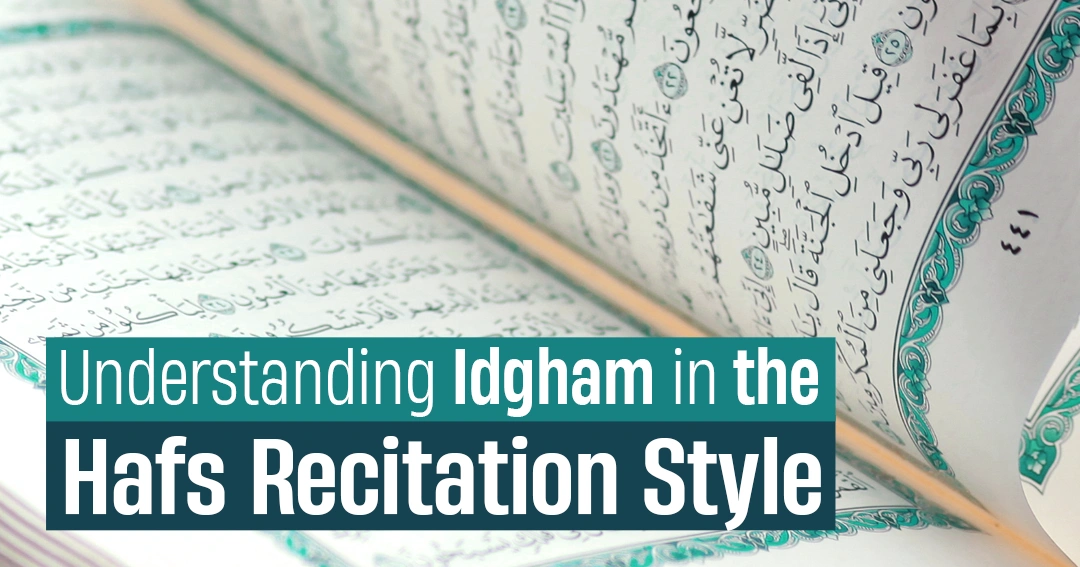Idgham in Hafs recitation is one of the fundamental Tajweed rules that all Quran students need to learn to read with accuracy and rhythm.
Whether you are a beginner or seeking to refine your recital, understanding how Idgham works will enhance both your reading and your relationship with the Quran. In this article, you will learn what Idgham is, when to apply it, and how to practice it correctly.
What Is Idgham in Hafs Recitation?
To begin with, Idgham in Arabic is “merging” or “blending.” By Idgham in Hafs recitation, we understand the Tajweed rule where a Noon Saakinah (نْ) or Tanween (ــًــٍــٌ) is merged into the succeeding letter.
Merging provides a smoother sound and maintains the natural rhythm of the Quranic verse, one of the distinguishing aspects of the beautiful Hafs recitation style.
The Role of Idgham in Hafs Recitation
Idgham in Hafs recitation is not just a technical rule, it’s a foundational element that preserves the beauty, clarity, and fluency of the Quran. It ensures there are no awkward pauses or broken sounds between words.
When applied correctly, it allows learners to pronounce Quranic verses in the way they were meant to be recited, as passed down through the authentic chain of Hafs ‘an ‘Asim.
When Does Idgham Occur?
Idgham in Hafs recitation takes place if a Noon Saakinah (نْ) or a Tanween-ending word is preceded by one of the six specific letters: ي، ر، م، ل، و، ن.
These six letters trigger the process of merging. Depending upon the specific letter, the Idgham may be with nasality (غُنَّة) or without nasality. Understanding when and how to apply this rule will help in perfect and smooth recitation of the Quran.
Learn Idgham in Hafs Recitation with Tareequl Jannah Academy
For learners eager to apply Idgham in Hafs recitation correctly, learning with qualified teachers makes all the difference. Tareequl Jannah Academy offers structured, learner-focused Tajweed courses that break down each rule into easy-to-follow lessons.
With live sessions, practical examples, and guided recitation practice, you’ll gain the confidence and skills needed to recite the Quran with precision and beauty.
Why Learners Should Prioritize Idgham in Hafs Recitation
Mastering Idgham in Hafs recitation helps learners move beyond basic reading and truly connect with the divine message of the Quran. It elevates your recitation, improves your pronunciation, and aligns your reading with the authentic methods of the Prophet ﷺ.
Whether you’re just starting your Tajweed journey or refining your skills, focusing on Idgham is a vital milestone.
Types of Idgham in Hafs Recitation
Now that you have the concept of merging sounds in Tajweed, it’s time to learn the different types of Idgham in Hafs recitation. They are divided based on whether the merging is with a nasal sound (ghunnah) or without it.

Understanding the difference between them helps you apply each rule accordingly and enhances the smoothness of your Quran recitation.
1. Idgham on Ghunnah in Hafs Recitation
This type of Idgham in Hafs recitation occurs when Noon Saakinah or Tanween is followed by one of the following four letters: ي، ن، م، و (Ya, Noon, Meem, Waw).
The sounds are mixed here, and a nasal sound (ghunnah) is added and continued for two beats. The ghunnah makes your recitation soft and melodic and is a feature of good Tajweed.
-
“مِن نِعْمَةٍ” – The Noon Saakinah (ن) becomes the Noon (ن) with a nasal sound.
Doing this repeatedly will help students commit the rhythm and pitch of Idgham with Ghunnah in Hafs recitation to memory.
2. Idgham without Ghunnah in Hafs Recitation
This form of Idgham in Hafs recitation is where Noon Saakinah or Tanween is followed by one of two particular letters: ل، ر (Lam or Ra). In this instance, the connecting is performed without a nasal sound. The effect is smoother-changing but without the distinct hum or echo that you perceive in ghunnah.
-
“مِن رَبِّهِمْ” – The Noon connects the Ra without nasalization.
Most students accidentally employ ghunnah here, which is not correct. Paying close attention to these subtleties will greatly improve the accuracy of your recitation.
Conditions for Applying Idgham
In order to apply the Idgham in Hafs recitation, students must understand the conditions under which this rule can be used.

These conditions are required because Idgham is not used in every case when Noon Saakinah or Tanween happens. Knowing when to apply Idgham—and when not to—is central to good Tajweed.
1. Idgham Only Between Two Words
One of the most essential conditions of Idgham in Hafs recitation is that the Noon Saakinah or Tanween must be at the end of a word, and the letter causing the Idgham must be at the start of the subsequent word.
When these two letters are within the same word, then the condition of Idgham is not met. Here is an example:
- “مِن وَلِيٍّ” – The Noon Saakinah in min is followed by the letter Waw at the start of the following word, thus Idgham with ghunnah is used.
Example where Idgham is not used:
- “دُنْيَا” – In this instance, the Noon and Ya fall inside the same word, hence no Idgham is created.
2. Certain Letters Must Come Before the Noon Saakinah or Tanween
As mentioned earlier, Idgham occurs only if the following letter is one of the letters of Idgham: ي، ن، م، و، ل، ر. If any other letter follows it, a different Tajweed rule applies, such as Izhār or Iqlāb.
So if you see a Noon Saakinah or Tanween, glance ahead and check the following letter. If it is one of the six specified letters, and it appears in the following word, then Idgham can be employed based on the category.
3. Ghunnah is Based on the Merging Letter
Another condition involving Idgham in Hafs recitation is whether or not a nasal sound (ghunnah) should be added. If the joining letter is ي، ن، م، و, ghunnah is applied. If the joining letter is ل or ر, it is joined without ghunnah.
Practical Examples from the Quran
Below are some practical examples from the Quran to help you see how Idgham in Hafs recitation works. These include both types—with ghunnah and without ghunnah—so you can easily recognize and practice them:
| Quranic Example | Type of Idgham | How to Pronounce It |
| مِن نعمة | With Ghunnah (ن + ن) | Merge the two ن letters with a nasal sound. Hold the ghunnah for two counts. |
| غفورٌ رحيم | Without Ghunnah (Tanween + ر) | Merge Tanween into ر smoothly without nasal sound. No ghunnah. |
| من والٍ | With Ghunnah (ن + و) | Merge the Noon into و with a nasal tone held for two counts. |
| سميعٌ عليم | No Idgham (Not a merging letter) | Read each word clearly. Do not merge—apply Izhār instead. |
| من لدنه | Without Ghunnah (ن + ل) | Merge the Noon into ل without nasalization. Keep the pronunciation smooth. |
| عليمٌ حكيم | No Idgham (Not a merging letter) | Pronounce clearly. No merging—this is Izhār. |
Tips for Mastering Idgham in Hafs Recitation
Mastering Idgham in Hafs recitation may appear confusing at first, but with the right direction and consistent practice, you will find that it becomes second nature.

The following are some simple yet helpful tips to direct you in mastering this important Tajweed rule and reciting the Quran confidently and elegantly.
1. Memorize the Idgham Letters
Start by memorizing the six letters that trigger Idgham in Hafs recitation:
-
ي، ن، م، و، ل، ر
Recognizing the letters that trigger combining—and those that do not—will enable you to spot Idgham at once when reading.
2. Know Ghunnah vs. Non-Ghunnah
Pay close attention to Idgham in Hafs recitation, which letters require ghunnah (nasal sound) and which don’t.
With Ghunnah:
-
ي، ن، م، و
Without ghunnah:
-
ل، ر
Practice by listening to your favorite Quran reciter so that you can clearly hear the difference and adapt your tongue to it.
3. Practice with Quranic Verses
Mushaf reading and identifying where Idgham in Hafs recitation occurs is one of the best ways of memorizing the rule. Begin with short surahs and try reading them slowly, applying Idgham wherever applicable.
4. Record and Listen to Your Recitation
Listen to yourself reading lines with Idgham. Later, compare your recitation to that of a Qari or a Tajweed teacher. Through this, you get to identify faults and enhance your recitation.
5. Learn from a Qualified Teacher
Even the most dedicated students need to be taught to perfect their recitation. That is why taking a Tajweed course can be a life-changer.
At Tareequl Jannah Academy, experienced teachers guide you through step-by-step learning rules like Idgham in Hafs recitation, with live practice, feedback, and real-life examples from the Quran.
6. Don’t Rush the Learning Process
Mastery is a process that takes time. Patiently learn each rule with yourself. Celebrate and make small daily improvements.
Conclusion
Mastering Idgham in Hafs recitation style of recitation is a stepping stone to reading the Quran correctly, beautifully, and clearly. Through learning rules, regular practice, and learning with experienced trainers, you can excel in Tajweed with confidence.
Deepen Your Understanding of Idgham Rule:
Discover the various types of idgham in tajweed and how they apply to Quranic recitation.
Explore real-life idgham letters with examples from Quran to solidify your grasp of Idgham letters.
Enhance your vocabulary and understanding of Idgham through specific words in Quran with idgham.
Break down language barriers with simplified explanations of idgham rules for non-native speakers.
Learn about the best online tajweed class idgham focus designed to help you master Idgham.





